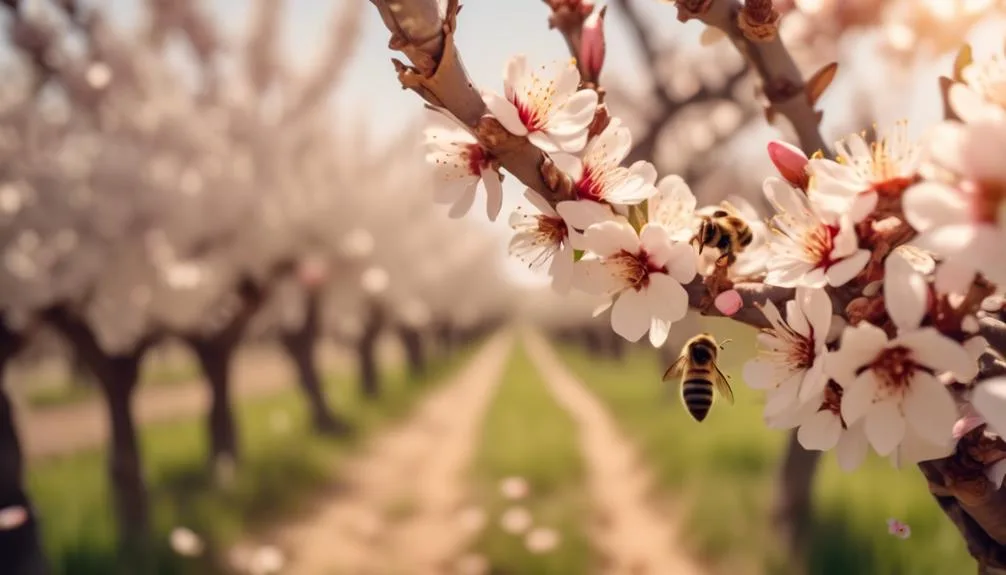Almond trees and bees are more connected than you might think. Bees rely on almond orchards for their health, and the decline of almond trees can have a big impact on bee populations.
The relationship between these two natural wonders is crucial to understand. But why are almond trees so important for bees? Let's find out.
Key Takeaways
- Almond trees rely on bee pollination for successful reproduction and yield.
- Almond orchards provide a rich and diverse environment that supports bee health.
- Almond blossoms are rich in nectar, providing critical nutrition for bees and facilitating pollination.
- The decline of almond trees can have negative consequences for bee populations and the ecosystem.
Almond Trees and Bee Pollination
Almond trees depend heavily on bee pollination for their successful reproduction and yield. The sustainability of almond trees relies on the presence of healthy bee populations.
Bees play a crucial role in pollinating almond blossoms, ensuring the development of almonds. To preserve bee habitat and support almond tree sustainability, it's essential to maintain diverse foraging areas and limit the use of harmful pesticides. Almond orchards can contribute to bee habitat preservation by incorporating flowering cover crops and minimizing soil disturbance.
The Role of Almond Orchards in Bee Health
Nestled among the blossoming almond trees, the vibrant orchards provide a rich and diverse environment that plays a crucial role in supporting the health and vitality of bee populations. In almond orchards, bee nutrition is a top priority for orchard management.
The nectar and pollen from almond blossoms offer essential nutrients for bees, aiding in their overall health and immune function. Proper orchard management practices, such as minimizing pesticide use during bloom, are crucial for maintaining a safe environment for bees.
Additionally, the vast acreage of almond orchards provides ample foraging opportunities for bees, contributing to their overall nutrition and well-being. By understanding the significance of almond orchards in bee health, it becomes evident that these orchards aren't only vital for almond production but also for sustaining healthy bee populations essential for ecosystem balance.
Almond Blossoms and Bee Foraging
Among the blossoming trees, the almond orchards create a vibrant landscape that beckons bees to forage for the essential nectar and pollen they need for sustenance and vitality.
Almond blossoms are rich in nectar, providing a critical source of nutrition for bees. The nectar is loaded with natural sugars, amino acids, and trace elements that are vital for bee health.
As bees collect nectar from almond blossoms, they inadvertently transfer pollen from one flower to another, facilitating the crucial process of pollination. This mutualistic relationship between almond trees and bees is essential for both the trees' reproductive success and the bees' survival.
The almond nectar not only sustains bee colonies but also contributes to the pollination of almond trees, ensuring the production of almonds, making it a win-win situation for both bees and almond orchards.
Impact of Almond Tree Decline on Bee Populations
With the decline of almond trees, a concerning impact on bee populations has become increasingly evident, highlighting the interconnectedness of these two vital components of the ecosystem.
The almond tree decline has led to:
- Loss of Bee Habitat: Almond trees provide an essential source of food and habitat for bees, and their decline disrupts this crucial aspect of bee life cycles.
- Reduction in Bee Diversity: The removal of almond trees can lead to a decrease in bee diversity, as these trees support a wide variety of bees, including both native and honey bees.
- Negative Impact on Bee Foraging: Almond tree decline restricts the foraging opportunities for bees, affecting their ability to gather nectar and pollen, which is detrimental to their overall health and population.
The decline of almond trees not only affects the almond industry but also has far-reaching consequences for the intricate balance of bee populations and the ecosystem.
Almond Tree Conservation for Bees
To support and sustain bee populations, the conservation of almond trees is of utmost importance. Almond tree partnerships and bee habitat restoration efforts play a crucial role in ensuring the survival of bee populations. Through collaborative initiatives, almond farmers and beekeepers can work together to create and maintain healthy bee habitats within almond orchards. This not only benefits the bees but also contributes to the overall health and sustainability of almond tree populations. By planting bee-friendly flora, providing nesting sites, and minimizing pesticide usage, almond tree partnerships actively support the restoration of bee habitats. This collaborative approach fosters a mutually beneficial environment where almond trees and bee populations can thrive together.
| Almond Tree Partnerships | Bee Habitat Restoration |
|---|---|
| Collaborative efforts between almond farmers and beekeepers | Planting bee-friendly flora |
| Creating healthy bee habitats within almond orchards | Providing nesting sites |
| Supporting the sustainability of almond tree populations | Minimizing pesticide usage |
Conclusion
In preserving almond orchards, we not only support bee populations but also safeguard our own food supply. The interconnectedness of almond trees and bees reminds us of the delicate balance in nature.
How can we continue to protect and nurture these essential partnerships for the benefit of our environment and future generations?

